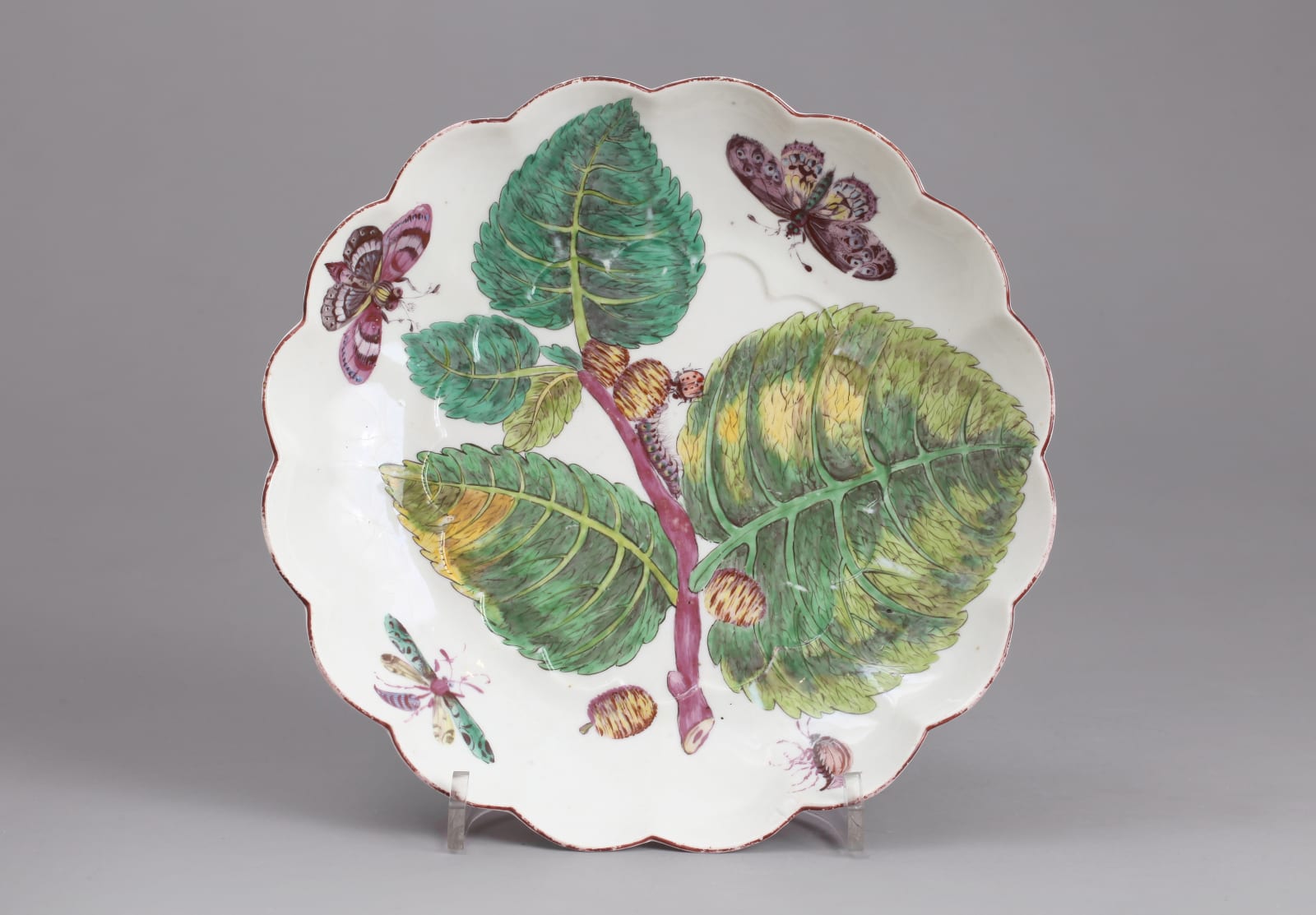
An extremely rare and fine Chelsea Porcelain shaped Circular Dish with ‘Hans Sloane’ type decoration of Mulberries, Circa 1752-55
An extremely rare and fine Chelsea Porcelain shaped Circular Dish with ‘Hans Sloane’ type decoration of Mulberries. Beautifully enamelled with a high degree of natural accuracy with a full leafy spray of fruiting Mulberry in tones of green, yellow and puce, a hairy caterpillar climbs up the stem together with a ladybird, surrounded by butterflies and moths in flight, within a puce brown line rim.
Taken by inspiration from either Elizabeth Blackwell, ‘A Curious Herbal.’ Vol. 1 pl 126, or J.W. Weinmann, ‘Phytanthoza Iconographica’. N.736. The term ‘Hans Sloane’ type that connects these botanical designs with Chelsea porcelain, comes from an advertisement in Faulkner’s Dublin Journal for the 1st July 1758. It was in Dublin that wares from the Piccadilly warehouse were sold sometime after the Spring sales at Mr Ford’s Great Room in the Haymarket, to give the objects or stock another ‘airing’ with the fashionable society of Dublin. The July 1758 sale mentions a tureen, ‘enamelled in curious Plants with Table Plates, Soup Plates and Desart Plates, enamelled from Sir Hans Sloanes Plants.’
Philip Miller curator or Head Gardener of the Chelsea Physic Garden, that had been leased in perpetuity by Sir Hans Sloane to the Society of Apothecaries, published ‘The Gardener’s Dictionary’, closely followed by ‘Figures of the most useful and uncommon Plants described in the Gardener’s Dictionary’. These volumes were full of engravings by George Dionysius Ehret, his own brother in law. These enlightenment publications together with Dr Christopher Trew’s volume ‘Plantae Selectae’, similarly illustrated by Ehret, and J.W Weinemann’s ‘Phytanthoza Iconographica (Regensberg 1737), provided the Chelsea enamelers with a raft of botanical inspiration for the wares of the Manufactory. The drama and panache of the botanically accurate specimens as if laid out across the porcelain creates a successful original botanical style developed by Sprimont at Chelsea.
Black Mulberries were naturalised within the environs of Chelsea having been originally planted by Sir Thomas More in 1525, just a stones throw away from Lawrence Street. The unripe fruit of the black Mulberry was said by Elizabeth Blackwell, the herbalist in the early part of the eighteenth century, to be ‘Binding and drying, good in all kinds of fluxes and inflammations of the mouth and the throat. The ripe fruit is cooling, good allay the heat of burning fevers and create an appetite’.
Mulberry leaf dishes with dark red and black berries were produced at Chelsea during the 1750’s and the fruit was eaten in pies and jellies.
A similar Lobed Circular Dish with the same botanical specimen formerly in the collection of Queen Elizabeth the Queen Mother, now in the Royal Collection of His Majesty King Charles III and at Clarence House.
Marks: Anchor mark picked out in red to the underside of the dish
Provenance
Private CollectionJoin our mailing list
* denotes required fields
We will process the personal data you have supplied in accordance with our privacy policy (available on request). You can unsubscribe or change your preferences at any time by clicking the link in our emails.